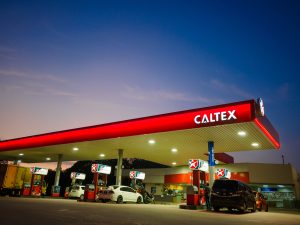With high fuel prices causing political and economic headaches around the world these days, now seems like a good time to do a quick explainer on the political economy of petrol in two neighboring but quite different energy markets, Malaysia and Indonesia. Both countries have historically had large reserves of oil and gas, the production and distribution of which is dominated by state-owned companies: Indonesia’s Pertamina and Malaysia’s Petronas. But that’s really where the similarities end.
Despite receiving billions in subsidies from the government, Pertamina has not been earning big profits lately and the government recently reduced subsidies, causing prices at the pump to rise and kicking off demonstrations around the country. Malaysia’s Petronas, on the other hand, has been reliably profitable, pays big dividends to the state, and has kept the price of diesel and RON 95 petrol steady despite volatility in global energy markets. Why can’t Pertamina be more like Petronas? Is this a simple case of government and corporate mismanagement?
Not exactly. Energy markets in Indonesia and Malaysia are fundamentally different, and thus the goals of policymakers and their economic agents – such as state-owned energy companies – are also going to be different. We need to understand these differences if we want to make sense of these divergent outcomes.
Indonesia was once a major global supplier of oil. There was a time when oil exports were basically the main source of revenue for the government, and the country’s economic health was closely tied to Pertamina. There wasn’t a lot of local demand in the 1970s, so Indonesian consumers could be supplied on the cheap while the surplus was exported at a healthy profit. Cheap petrol for Indonesian consumers is a legacy of that era.
Those days are over. In 2021, Pertamina’s domestic sales of oil and gas reached $39.3 billion, compared to $8.3 billion in exports. The domestic market is now overwhelmingly the key market, and it consumes most of what is produced in Indonesia. This is a bit of a problem, because Indonesia is producing less than it used to while consumers have gotten used to the days of abundant and cheap oil.
According to the Ministry of Energy, Indonesia’s proven oil reserves fell from 4 billion barrels in 2011 to 2.25 billion in 2021. Domestic crude production decreased from 329 million barrels in 2011 to 240 million in 2021. Pertamina’s limited refinery capacity means that it has become ever more reliant on imports and thus more sensitive to swings to global energy prices.
Because the domestic market dominates Pertamina’s business, and because pricing for domestic consumption is as much about politics as it is about economics, we shouldn’t expect Pertamina to chase profits or to be run like a normal business. We should expect the primary goal to be keeping Indonesian consumers insulated from big price increases. And indeed, fuel prices are still lower than they would be if they reflected true market conditions.
Petronas, on the other hand, is built differently. For one thing, Malaysia has a much smaller domestic market than Indonesia, accounting for only around 26.5 percent of revenue in 2021. Just like Pertamina in the 1970s, the major share of what it produces can be sold outside of Malaysia at competitive prices rather than sold to domestic consumers at lower rates.
Petronas also has a much more extensive global production and distribution network, which means it is not oriented toward the domestic market to the same extent as Pertamina. This makes it easier for Petronas to act like a more traditional, profit-maximizing business. During times of high oil prices it can book big profits from upstream production, while keeping the retail cost of petrol for Malaysian consumers stable. On the flip side, this global exposure also means Petronas performed quite poorly in 2020 when the pandemic caused demand to dry up.
The production and distribution of energy is structured quite differently in Indonesia than in Malaysia, reflecting structural factors such as market size and domestic supply. Such factors will naturally be translated into distinct pricing strategies and business operations at each of the state-owned oil and gas companies. So when petrol prices go up in Indonesia while holding steady in Malaysia even as Petronas books healthy profits, the comparison is not so clear cut as it may seem.

































